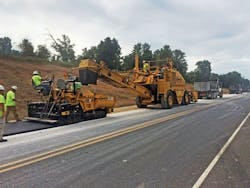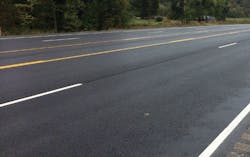By: Brandon Finn; Contributing Author
What does it take to create a superbly smooth pavement?
The formula applied by Hutchens Construction for a recent project on Highway 62 in northwest Arkansas involved a bit of technology, a devotion to best practices and some wisdom from an ancient Greek philosopher.
In late 2013, Nabholz Corp. won a contract with the Arkansas State Highway and Transportation Department (AHTD) to widen Highway 62, a major east-west corridor connecting the towns of Avoca and Garfield. The work consisted of widening the existing two-lane roadway to four lanes with a dedicated center turn lane. This meant rehabbing or notch-widening existing sections of the roadway and relocating other sections to accomplish the widening project.
Nabholz enlisted the services of local asphalt material producer and paving contractor Hutchens Construction to perform the asphalt paving on the project. Hutchens Construction, headquartered in southwestern Missouri, maintains a construction presence in northwest Arkansas with three asphalt plants in the region providing service for residential, commercial, municipality and AHTD projects. For this project, Hutchens used its asphalt plant in Springdale, Ark., about 20 miles from the western edge of the project.
Understanding the importance of delivering quality asphalt consistently to this project, Hutchens Plant Operator Joe Parrington and Vice President of Manufacturing Brandon Finn worked closely with Wayne Mondier, a quality control technician at Material Testing of Arkansas, to ensure that the asphalt mixture delivered to the job consistently met project specifications.
The Highway 62 expansion project utilized some sections of the existing pavement structure but also required new full-depth pavements to be constructed in relocated sections of the project. Typical sections for the notch-and-widen areas consisted of 5 in. of 37.5-mm base mix, 4.5 in. of 25-mm binder mix, 2 in. of 12.5-mm intermediate surface mix and 2 in. of 12.5-mm final wearing surface. Typical sections for the relocated areas consisted of 6 in. of 25-mm binder mix, 2 in. of 12.5-mm intermediate surface mix and 2 in. of 12.5-mm final wearing surface.
The two-year Highway 62 project resulted in one of the lowest profile indices in Arkansas—and is one of the state’s smoothest roads.
Getting underway
Asphalt paving for this scheduled two-year project commenced in Spring 2014 and was completed in early October 2015 under the direction of Troy Sizemore, paving superintendent for Hutchens.
This project was typical of many widening and relocation projects that require phased construction, lane shifts, grade building to establish a new road profile on existing pavement sections, and multiple-lift construction. What was not typical of this project was the forethought and methodology required to meticulously construct a pavement of superior smoothness; however, Hutchens operates on a corporate philosophy espoused by president Phil Hutchens, and borrowed from the Greek philosopher Aristotle: “Excellence is an art won by training and habit. We do not act rightly because we have virtue or excellence, but we rather have those because we have acted rightly. We are what we repeatedly do. Excellence, then is not an art but a habit.”
Constructing the asphalt pavement in multiple lifts allowed Hutchens Construction to utilize grade-control technology to ensure a uniform pavement. It also allowed them to address any areas that had profile deviations that could potentially cause “bumps” or variations in the smoothness of the final wearing surface. After completing construction of the 25-mm binder course, the entire pavement was profiled, areas of profile deviation were identified, and a plan for remediation was established.
With the remediation plan in place, any profile deviation was ground using a Flatliner to ensure a uniform pavement smoothness. The Flatliner is a pavement smoothness skid-steer attachment manufactured by Keystone Engineering specifically designed for bump grinding, ride-quality improvement of pavements and pavement marking or coatings removal. Crews used a Model FL48 Flatliner, which offers a 49-in. grinding width and has the capability of grinding variable depths ranging from nil to 1 in. The FL48 Flatliner has 140 grinding bits that shave the pavement surface rather than impacting the pavement like traditional conical milling teeth. This allows for remediated variability in the pavement profile without adversely affecting pavement surface texture.
Sizemore set firm guidelines for pavement remediation, mandating that any area exhibiting a deviation that did not meet the ultimate specification for the final wearing surface should be remediated before beginning placement of the intermediate wearing surface. While placement of two additional 2-in. surface lifts atop the binder course would address and eliminate many of the deviations, it was determined that time and cost savings could be realized by addressing the issue from the outset.
“Jay Hensely, a former Asphalt Institute engineer, once told me that for every 1 in. of additional asphalt placed, a deviation can be corrected by about 25%. Reasoning would tell you that with 4 in. of asphalt left to place, the deviations we were identifying would ultimately meet the specification for the final wearing surface, but we felt that remediating the deviations before placing the two additional surface lifts would drastically improve the quality of the finished pavement,” Hutchens said.
Indeed, many studies have shown that pavement longevity is directly affected by pavement smoothness. Hutchens knew that the smoother they could make the profile of the binder course, the smoother and more durable the final wearing surface would be. After taking corrective action on the deviations in the binder course, the 2-in. intermediate surface course was installed, and the process of profiling the entire pavement and identifying any deviations not meeting specification for the final surface course was repeated.
Once again, areas identified as being out of tolerance were ground using the FL48 Flatliner to ensure that the intermediate surface pavement was smooth and devoid of any deviation that could negatively impact the ride quality of the final wearing surface.
Numbers don’t lie
With the intermediate surface deviations identified and corrective action taken, workers installed the final wearing surface, matching paving speed to material supply. They employed a Weiler 2850 MTV to transfer material from delivery trucks to the Cat 1055E paver, and were able to minimize roller lash by extending transition areas and, when possible, starting and stopping roller operations on the adjacent mat.
When all is said and done, the numbers don’t lie. After completing construction of the final wearing surface, profile index numbers were collected for each 1⁄10-mile section of pavement on both the east- and westbound lanes. Compiling all the collected data revealed an average profile index for the project of 0.910 in./mile, representing the cumulative deviations in in./mile for readings falling outside of the blanking band.
In layman’s terms, this pavement is seriously smooth. Jeremy Bolt with Level Best, the company contracted by Hutchens Construction to perform the project profiling, said, “I have performed profiling on over 50 projects for contractors across Arkansas, and this was one of the lowest profile indices I have seen.” Moreover, the AHTD provided incentive payments proportional to ride quality for this project, which helped to offset the costs of the additional labor and equipment needed to produce a pavement with such a low profile index.
This project is a testament to the belief that excellence is not an art, but it is indeed the result of habitually performing the tasks that can provide excellent results. Although special equipment was used during the construction of this asphalt pavement, that equipment is not what makes this project special. It was the acute attention to detail, the preparedness and the willingness to go above and beyond what is perceived to be industry best practices that contributed to ultimate success on the Highway 62 project. AT
About The Author: Finn is vice president of manufacturing for Hutchens Construction.





